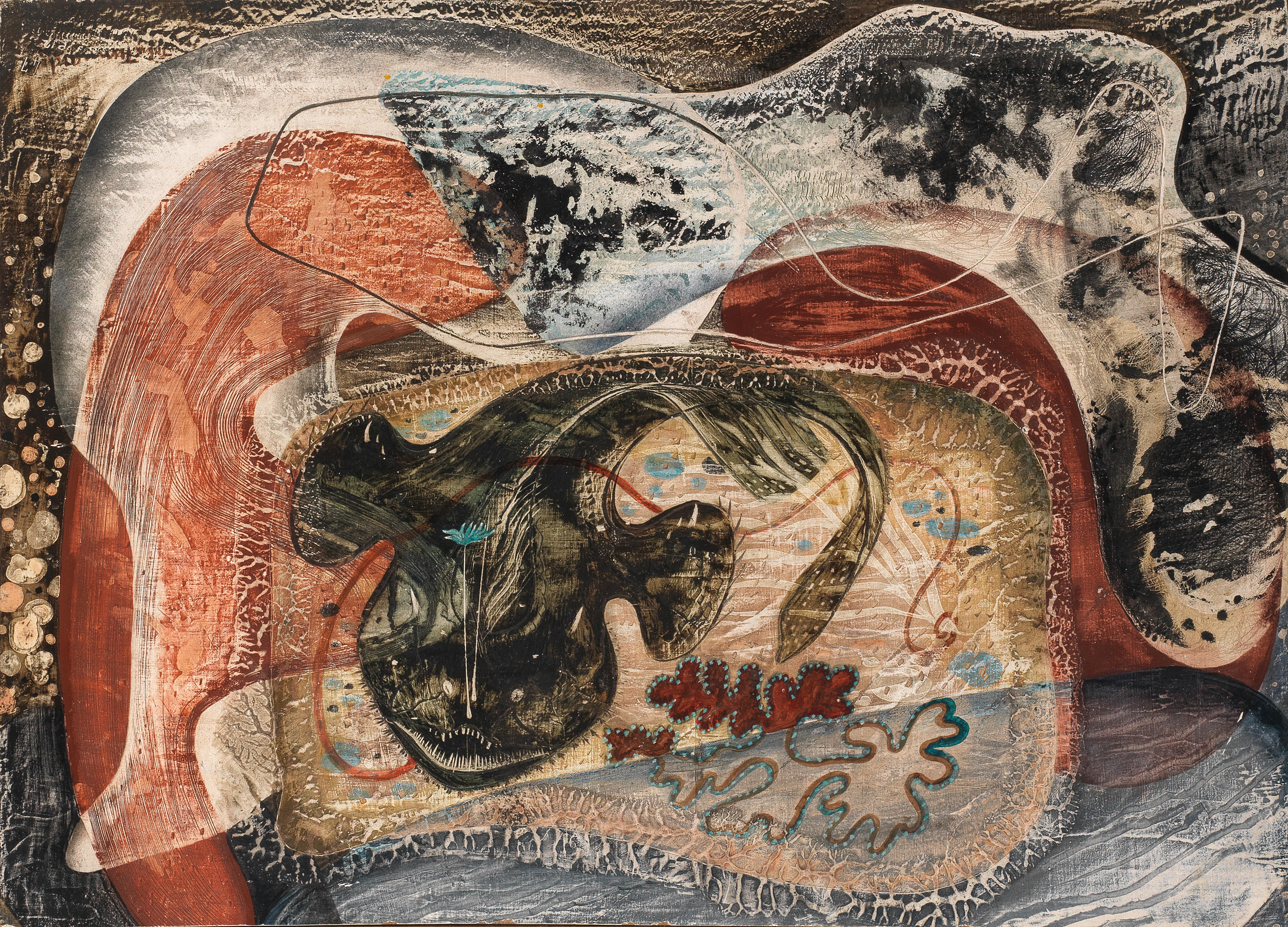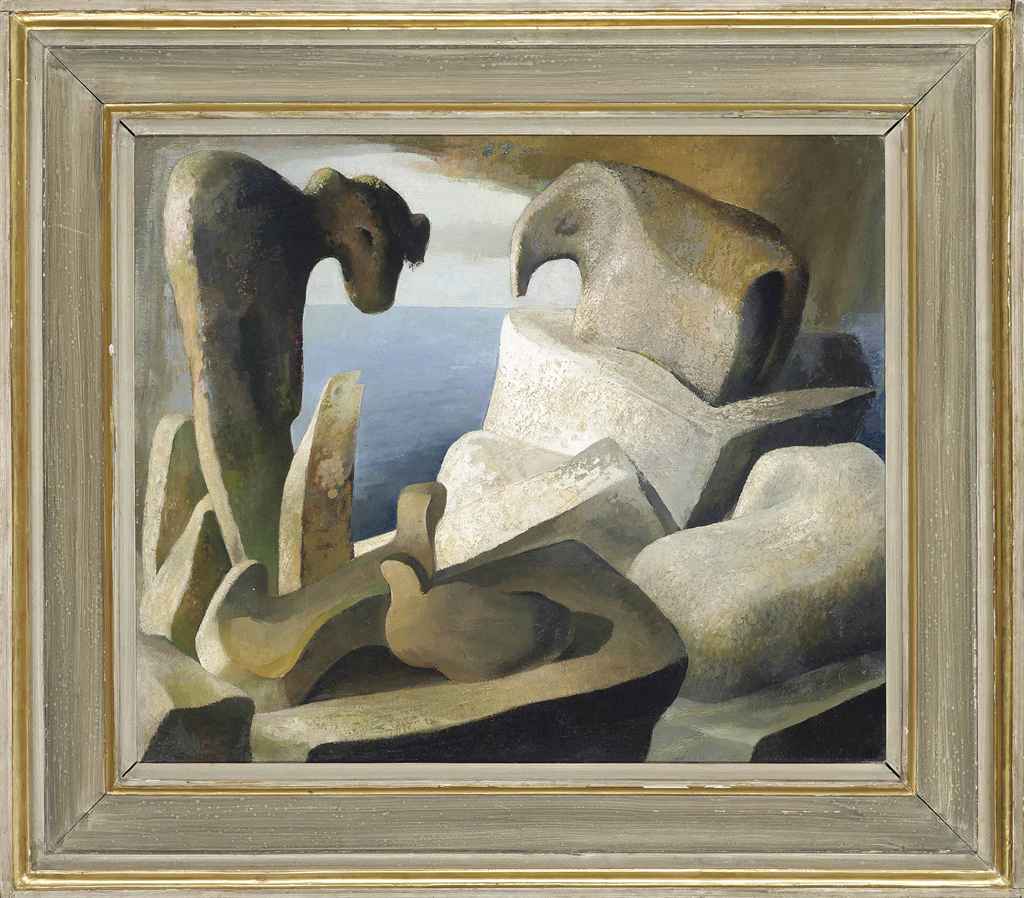John Tunnard A.R.A. (British, 1900-1971) Painting No.1 signed and dated 'John Tunnard/1939' (lower left); further signed and titled 'Painting/No 1/John Tunnard' (verso) tempera on gesso-prepared board 91.3 x 121.8 cm. (36 x 48 in.) Fußnoten Provenance Tunnard Estate, until 1988 With McRoberts and Tunnard Ltd., London With Gillian Jason Gallery, London Sale; Christie's, London, The Poetry of Crisis; The Peter Nahum Collection of British Surrealist and Avant-Garde Art 1930-1951, 15 November 2006, lot 100, where acquired by the present owner Private Collection, U.S.A. Exhibited Cardiff, Arts Council of Great Britain, The National Museum of Wales, British Art and the Modern Movement 1930-40, 13 October-25 November 1962, cat.no.56 London, Marlborough Fine Art, Art in Britain 1930-40 Centered around Axis Circle Unit One, March-April 1965, p.85, cat.no.163 (ill.) London, Royal Academy, John Tunnard 1900-1971, 5 March-11 April 1977, cat.no.19; this exhibition travelled to Cambridge, Kettle's Yard, 14 May-7 June, Kettering, Kettering Art Gallery, 11 June-2 July, Manchester, Manchester City Art Gallery, 16 July-14 August, Newcastle-upon-Tyne, Laing Art Gallery, 20 August-11 September and Penzance, Newlyn Art Gallery, 1-29 October 1977 Swansea, Glynn Vivian Art Gallery, Contrariwise: Surrealism and Britain 1930-1986, 20 September-15 November 1986, p.45, cat.no.142 (ill.) Aldeburgh, Peter Pears Gallery, Festival Exhibition, 9-24 June 2006, cat.no.14 Literature Alan Peat & Brian Whitton, John Tunnard His Life and Work, Aldershot, 1997, p.150, cat.no.149 (ill.) 'John Tunnard's work has the same kind of architectural precision (as Ben Nicholson's), but behind it is a warmth that is missing from Mondrian, and a depth that is lacking in Ben Nicholson' (Eric Newton, critic for The Listener, Alan Peat & Brian A Whitton, John Tunnard His Life and Work, p.72). In 1938 John Tunnard introduced himself to Peggy Guggenheim, the renowned collector who was running the Guggenheim Jeune Gallery, which would prove to be one of the most fortuitous meetings of his career. She was so impressed by his work and pitch that she offered him an exhibition on the spot and from there his reputation and success soared. In her autobiography, Peggy recalled 'One day a marvellous man in a highly elaborate tweed coat walked into the gallery. He looked like Groucho Marx. He was animated as a jazz-band leader; which he turned out to be. His colour was exquisite and his construction magnificent.' (Op.Cit., p.53). The subsequent war years were a time of intense productivity with exhibitions not only at Guggenheim Jeune but also other esteemed galleries such as Lefevre, Redfern and Zwemmer, among others. As his artistic circle widened so too did admiration for his work, both publically and from his contemporaries, with Ivon Hitchens penning '...the pleasure given my wife and myself by various pictures of yours during the past few years – brought to a head yesterday at the R.A. private view when looking at your paintings there. They have the quality of life – that all paintings should have – but so much contemporary work hasn't got. May you go forward and prosper. Good luck..." (Op.Cit., p.60). Outside of his British circle of fellow artists that included Henry Moore Ben Nicholson and Julian Trevelyan among others, Tunnard was equally aware of the latest trends in European art, especially that of surrealism. His work has similarities to Yves Tanguy (1900-1955) and Max Ernst (1891-1976), the former of which also had a one-man show at Guggenheim Jeune Gallery one year after Tunnard's in 1939. The use of the straight white line attached to semi-geometrical forms was a feature of Ernst's work that is also prevalent in Painting No.1. The present work encapsulates John Tunnard's skill in assembling disparate forms together successfully to produce a unified composition and the end result is hypnotic. In Painting No.1, the viewer is confronted with a series of frames within frames se
John Tunnard A.R.A. (British, 1900-1971) Painting No.1 signed and dated 'John Tunnard/1939' (lower left); further signed and titled 'Painting/No 1/John Tunnard' (verso) tempera on gesso-prepared board 91.3 x 121.8 cm. (36 x 48 in.) Fußnoten Provenance Tunnard Estate, until 1988 With McRoberts and Tunnard Ltd., London With Gillian Jason Gallery, London Sale; Christie's, London, The Poetry of Crisis; The Peter Nahum Collection of British Surrealist and Avant-Garde Art 1930-1951, 15 November 2006, lot 100, where acquired by the present owner Private Collection, U.S.A. Exhibited Cardiff, Arts Council of Great Britain, The National Museum of Wales, British Art and the Modern Movement 1930-40, 13 October-25 November 1962, cat.no.56 London, Marlborough Fine Art, Art in Britain 1930-40 Centered around Axis Circle Unit One, March-April 1965, p.85, cat.no.163 (ill.) London, Royal Academy, John Tunnard 1900-1971, 5 March-11 April 1977, cat.no.19; this exhibition travelled to Cambridge, Kettle's Yard, 14 May-7 June, Kettering, Kettering Art Gallery, 11 June-2 July, Manchester, Manchester City Art Gallery, 16 July-14 August, Newcastle-upon-Tyne, Laing Art Gallery, 20 August-11 September and Penzance, Newlyn Art Gallery, 1-29 October 1977 Swansea, Glynn Vivian Art Gallery, Contrariwise: Surrealism and Britain 1930-1986, 20 September-15 November 1986, p.45, cat.no.142 (ill.) Aldeburgh, Peter Pears Gallery, Festival Exhibition, 9-24 June 2006, cat.no.14 Literature Alan Peat & Brian Whitton, John Tunnard His Life and Work, Aldershot, 1997, p.150, cat.no.149 (ill.) 'John Tunnard's work has the same kind of architectural precision (as Ben Nicholson's), but behind it is a warmth that is missing from Mondrian, and a depth that is lacking in Ben Nicholson' (Eric Newton, critic for The Listener, Alan Peat & Brian A Whitton, John Tunnard His Life and Work, p.72). In 1938 John Tunnard introduced himself to Peggy Guggenheim, the renowned collector who was running the Guggenheim Jeune Gallery, which would prove to be one of the most fortuitous meetings of his career. She was so impressed by his work and pitch that she offered him an exhibition on the spot and from there his reputation and success soared. In her autobiography, Peggy recalled 'One day a marvellous man in a highly elaborate tweed coat walked into the gallery. He looked like Groucho Marx. He was animated as a jazz-band leader; which he turned out to be. His colour was exquisite and his construction magnificent.' (Op.Cit., p.53). The subsequent war years were a time of intense productivity with exhibitions not only at Guggenheim Jeune but also other esteemed galleries such as Lefevre, Redfern and Zwemmer, among others. As his artistic circle widened so too did admiration for his work, both publically and from his contemporaries, with Ivon Hitchens penning '...the pleasure given my wife and myself by various pictures of yours during the past few years – brought to a head yesterday at the R.A. private view when looking at your paintings there. They have the quality of life – that all paintings should have – but so much contemporary work hasn't got. May you go forward and prosper. Good luck..." (Op.Cit., p.60). Outside of his British circle of fellow artists that included Henry Moore Ben Nicholson and Julian Trevelyan among others, Tunnard was equally aware of the latest trends in European art, especially that of surrealism. His work has similarities to Yves Tanguy (1900-1955) and Max Ernst (1891-1976), the former of which also had a one-man show at Guggenheim Jeune Gallery one year after Tunnard's in 1939. The use of the straight white line attached to semi-geometrical forms was a feature of Ernst's work that is also prevalent in Painting No.1. The present work encapsulates John Tunnard's skill in assembling disparate forms together successfully to produce a unified composition and the end result is hypnotic. In Painting No.1, the viewer is confronted with a series of frames within frames se


.jpg)












Testen Sie LotSearch und seine Premium-Features 7 Tage - ohne Kosten!
Lassen Sie sich automatisch über neue Objekte in kommenden Auktionen benachrichtigen.
Suchauftrag anlegen